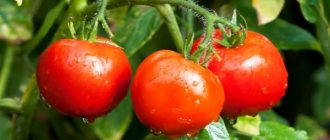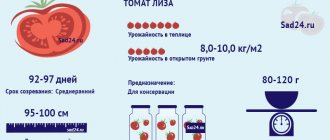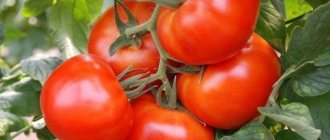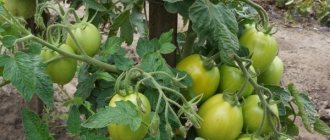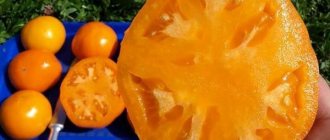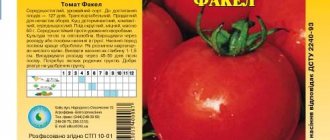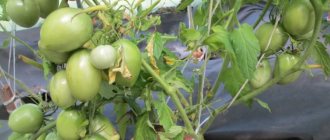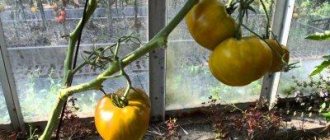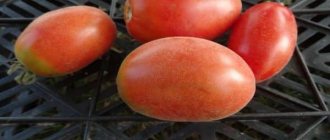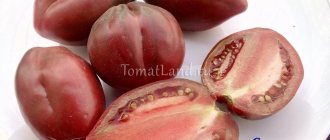The Carrot tomato has beautiful bushes and fruits, grows well in open ground, and the tomatoes are tasty and juicy. It's easy to grow and will garnish any salad.
| Height | Landing location | Ripening time | Fruit color | Fruit size | Origin | Fruit shape |
| short | Greenhouse, Open ground | Early ripening | Reds | Average | Variety | Flat-round |
Botanical description
Tomatoes of the “Carrot” variety are low-growing and hardy; they will feel great both in greenhouse conditions and in open soil. The plant has a characteristic, easily recognizable appearance, and its fruits have a good taste.
Bushes
The height of “carrot” bushes is 80-90 cm , but if you fertilize the soil very well, this value may increase by several centimeters. Upon external examination, highly dissected leaf plates immediately become noticeable, because of the appearance of which this tomato variety got its name (the leaves really look like carrot tops). Each brush produces 6-7 tomatoes.
Fruit
All tomatoes ripened on the bushes are orange-red in color and characterized by a flat-round shape. When palpated, it is easy to notice slight ribbing, and if you cut the fruits, you can see the multi-chambered structure of their inner part. Each tomato weighs approximately 100-150 g and has good taste: the pulp has a standard tomato aroma, but tastes sweeter and juicier.
The harvest of the “Carrot” variety is excellent both for fresh consumption and for further preparation of preparations for the winter.
Description and characteristics of the variety
The Carrot tomato has determinate bushes reaching 80-90 cm. The leaves are very carved, similar to the foliage of carrots, which gave the variety its name. The inflorescences are simple, the fruits grow in clusters of 6-7 pieces. Characteristics and description of the fruit: medium-sized tomatoes, 100-150 g each, flat-round in shape with visible ribbing. The largest ones reach 220 g. Their color at maturity is orange-red. There are many seed chambers inside. Rich tomato taste, universal use.
Tomato "Carrot": advantages and disadvantages
If you carefully read the characteristics of the variety, the advantages of “Carrot” are obvious. First of all, these are early ripening, good taste of the fruit, consistently high yields and resistance to major tomato diseases, which often destroy a significant part of the tomato crop. As for the shortcomings, they are indeed difficult to detect, and if there are cases of low yield or poor plant growth, most often this is the result of improper care.
The best late varieties and hybrids of carrots for winter storage
Samson F1 (Holland, 2001)
- marketability 91 - 94%
- evenness
- excellent keeping quality
- not suitable for harvesting by pulling leaves
Canada F1 (Holland, 2001)
- high productivity
- marketability 93 - 95%
- evenness
- excellent taste
- adapted to heavy soils
- color resistance
- good immunity
- suitability for long-term storage
- does not tolerate waterlogging
- easily outgrows “comfortable” sizes
Anastasia F1 (Holland, 2007)
- high yield
- marketability 82 - 92%
- crack resistance
- good taste
- excellent preservation during long-term storage
- prone to deformation on heavy soils
- demands on agricultural technology
Queen of Autumn (Russia, 2005)
- high yield for the variety
- color resistance
- does not crack
- keeps well until new harvest
- average marketability
- bends on heavy soils
How to plant a Carrot tomato
Tomatoes of the "Carrot" variety are grown using the same seedling method as most others. At the same time, it is important to follow the timing and rules of sowing and transplanting seedlings, as well as pay due attention to the optimal scheme for planting grown plants on the site.
Terms and conditions for landing
It is recommended to sow “carrot” seeds for seedlings 50 days before transplanting them into open areas, that is, around March or early April. Picking of seedlings is carried out after the appearance of the first true leaf, and transplantation to a permanent place of growth is carried out in mid-May or early June.
If you have a heated greenhouse, then you can sow tomatoes directly into the beds (in April), and if there are film covers, sowing is carried out in May (in which part of the month - you need to decide individually, based on your climatic region and temperature conditions). These temporary values must be observed if you want to get a rich harvest within a clearly defined time frame.
Features of cultivation and proper care
Any tomatoes will feel good in areas rich in organic matter, so when preparing the bed for replanting, it is worth adding appropriate fertilizers to the soil.
Calculation of fertilizers per 1 m²:
- 10 kg organics;
- 20 g of potassium and phosphorus (embedded in the ground in the fall);
- 10 g of nitrogen-containing compounds.
During the season itself, tomatoes of the “Carrot” variety are fed 20 days after planting the seedlings and another 20 days later, during the mass appearance of fruits. The simplest option for fertilizing the soil is to use dry ready-made fertilizers, which are embedded in the rows (per 1 m² there should be no more than 5 g of nitrogen-containing compounds and 10 g of potassium and phosphorus fertilizers).
Watering and loosening the soil when caring for “carrot” tomatoes, as well as fertilizing them, are carried out throughout the entire growing season. In addition, tomatoes need moderate pinching.
If you comply with all agrotechnical requirements and take a responsible approach to the selection of seeds, you will be able to taste delicious and large tomatoes of the “Carrot” variety in record time, without a significant investment of time and labor. And the non-standard type of bushes will allow you to stand out among the owners of garden plots in the neighborhood.
Tomato variety with carrot leaves Carrot
- Your Cart
- In the cart of goods in the amount of: 0 rubles
- Open cart
- Price: 20 rubles
- Price: 30 rubles
- Price: 25 rubles
- Price: 20 rubles
- Price: 20 rubles
- Price: 25 rubles
- Price: 30 rubles
- Price: 20 rubles
- Price: 25 rubles
- Price: 30 rubles
- Price: 30 rubles
- Price: 25 rubles
- Price: 20 rubles
- Price: 25 rubles
- Price: 30 rubles
- Price: 25 rubles
- Price: 35 rubles
- Price: 30 rubles
- Price: 20 rubles
- Price: 35 rubles
- Price: 25 rubles
- Price: 0 rubles
- Price: 600 rubles
- Old price: 750
- Price: 30 rubles
- Price: 30 rubles
- Price: 30 rubles
- Price: 25 rubles
- Price: 25 rubles
- Price: 25 rubles
- Old price: 30
- Price: 25 rubles
- Price: 25 rubles
- Price: 25 rubles
- Price: 30 rubles
- Price: 30 rubles
- Price: 25 rubles
- Price: 30 rubles
- Price: 25 rubles
- Price: 30 rubles
- Price: 25 rubles
- Price: 20 rubles
- Price: 20 rubles
A little history
The tomato is the fruit of a perennial nightshade plant called tomato.
This word and the plant itself came to Russia from France, and to France from Italy, presumably in the 16th century. In Italy, the plants were called pomo d'oro - “golden apple” and they were yellow-sunny in color, because this is how the Mays and Aztecs grew them, believing that “tomatli” were sent to them by the solar goddess of medicine, health and healing - Ishtilton (Ichtilton) .
The Spaniards, who introduced Europe to this golden berry after 1520, introduced it as “pomidel de Peru” - “apple from Peru.” The loving French gave the “apple” its own name, which the Russians also used for a long time - “une pomme d’amour” - “love apple”.
Both the French and the Spaniards used tomatoes as a remedy for coughs and as a powerful remedy for increasing potency, but frequent consumption of la mela d'oro (“golden apple” - Italian), according to scientists of that time, threatened death.
Such a gift for anyone's heart!
In 1780, new fruits from Italy were served at the table of Catherine the Second, most of which were “golden apples”. The empress liked the new fruit so much that by the greatest decree it was ordered to plant this vegetable for the imperial table and the process of Russification of the Italian “love” berry took on unprecedented proportions.
Let's start with the yellow-orange pomo d'oro, the color "pommel de Peru"!
Honey Saved, Persimmon and Oxheart Orange and Gold. Golden heart
Honey saved
Filled with honey to the brim...
Typically, orange-colored tomatoes are considered more acidic than those with a “skin” of a different color. But these three have an excellent sweet taste! Especially Honey saved!
Bred by such a breeding luminary as V.N. Derenko, Honey Spas, registered in 2004 as a “variety for greenhouses and open ground,” quickly won its place in each region of Russia.
Growing freely in a greenhouse up to 2 m in height (in open ground - up to 170 cm), this nightshade forms on one cluster up to 6 large, round orange or deep yellow, rich berries covered with large green leaves. Berry weight up to 250 g.
Until the “child of the bush” has reached full maturity, a dark green spot remains at the top, near the stalk, which disappears as soon as the pomo d'oro is fully ripe.
Ripe pomo d'oro keeps well in the refrigerator until winter.
Here is a flattering review of Medov:
“I sowed the seeds in mid-March, since I don’t use lighting. The seedlings grew well and strong (spring brought us plenty of sunny days). I planted my tomatoes already in mid-May. I grow a lot of different ones in order to select the best ones for myself.
But the weather in the summer of 2014 was not on the side of gardeners; heavy torrential and prolonged rains were followed by heat. Many died, but Honey saved us, and the first babies on it had already matured by July 20, although it was declared as average, while the well-known Riddle gave nothing at all.
My Honey Spa fruited the longest and lasted until the last and survived the fight against late blight. The last tomatoes were picked clean and healthy, although not very ripe. Honey Spas showed its best side even in not very favorable conditions. Sow this variety and you won’t regret it!”
Persimmon
It even looks sweet!
The Persimmon tomato is not so tall - only 70-90 cm in open ground and 120-140 cm in a greenhouse. Needs a garter. This nightshade has good yields, but is susceptible to frequent diseases.
The shape of the Persimmon berry resembles a persimmon, weighing 350-400 g. Ripe Persimmon is very sweet and fleshy, but overripe ones begin to sour. Excellent for both salads and canning.
Persimmon is the leader in beta carotene content among yellow and orange varieties!
There is no exact definition for ripeness. Judging by the reviews, some believe that ripeness is in a bright, orange-yellow color, others argue that this color is a sign that the Persimmon is already overripe.
To get acquainted with the orange-sunny Persimmon, we suggest watching a short video:
The best varieties of tomatoes - part two
We continue to publish a series of the best varieties of tomatoes.
So, we present to your attention
Tomato Emerald apple
An unusual variety, distinguished by its emerald flesh, sweet and juicy taste. Tomato weight - up to 250g. Bushes up to 1.3 meters high. From each one you can harvest up to 10 kilograms of harvest. It begins to bear fruit from July until September.
Tomato Emperor
It comes in red and pink. The variety is mid-early, very productive - up to 12 kg per bush. The plants are spreading, with a powerful root system, tall - up to 170cm. Each one produces many fruits weighing about 150-250 grams. The shape of the tomatoes is elongated. Excellent for preparations and salads.
Tomato Iris
Also early ripening, grows up to 1.2 m, bears fruit in July. Tomatoes are round in shape, 10-15 of them are tied on each bush. Weight - 50-60 grams. Up to 5 kg is collected from the bush. The purpose is universal.
Tomato Long Keeper
Refers to the later ones. The good thing is that its fruits can be stored at home for a very long time. It grows up to 1.5 meters, on each cluster there are 5-6 tomatoes weighing 100-150 grams. The shape is slightly flattened.
The fruits ripen only on the lower cluster; the rest are usually collected green and allowed to ripen at home - there they will turn orange-yellow.
The interesting thing is that if stored properly, undamaged tomatoes can last until the next harvest! Up to 6 kg are collected from the bush.
Tomato Raspberry Lamp
Unusual raspberry-colored tomatoes, shaped like a lamp. They weigh 60-80g. The bushes reach a height of up to 2.5 meters. The ripening period is medium-late. Each cluster contains 6-9 tomatoes.
The skin of the fruit is thick, the flesh is dense, they tolerate heat treatment well and do not crack. An excellent option for marinating. Fruiting begins in mid-July, and can be collected until frost.
Tomato Marmande
An early, large-fruited variety from Holland. It grows in height up to one and a half meters, the tomatoes are red, flat-round, slightly spotted, firm, with excellent taste. They weigh 150-200g. Wonderful both in preparations for the winter and in salads. Productivity - 7 kg.
Carrot tomatoes
The variety is early ripening, low - up to 90 cm. The heavily dissected leaves look like carrots. On a cluster there are 4-6 fruits weighing 90-120g, flat-round shape, carrot color. Productivity - 4-5 kg. Fruiting: July - August. We have already written about the Moscow Delicacy, let us only remind you of its popularity.
Tomatoes Novy Goshary
The second name is dry tomatoes. An original variety with fruits that are hollow inside and resemble sweet peppers in their structure. Mid-season, perfect for stuffing. Fruits weigh 80-120g, yield - 6kg.
Tomato variety Orange Cream
Medium-sized, mid-ripening, height - up to 160cm, productive (up to 6kg), unusual variety. The tomatoes are bright orange in color and look like cream. Weight - 40-60g, unusual taste, crispy, sweet and sour. Ideal for canning and fresh. Fruiting is also pleasing - from mid-July until frost.
Pepper tomatoes
Fleshy, sweet, medium-sized (1.4 m), mid-early original variety. The tomatoes are pepper-shaped, red in color, weigh up to 100 grams, sweet, practically without seeds and without liquid. You can remove up to 6 kg from a bush. It is necessary to collect every day, since this variety has one drawback - the fruits do not stick well to the hands and fall off.
Tomato variety Roma
The second name is Rome. Mid-early, extended fruiting period, height - up to 1.6 m, abundant fruiting. The tomatoes are red, beautiful, smooth, plum-shaped, weighing up to 100g, up to 20 pcs per bunch. The pulp is tasty, there are few seeds, but there is a lot of sugar and dry matter. Ideal for whole canning, including in its own juice.
Russian Giant
Large-fruited, with heavy fruits (dense structure and, accordingly, large weight of each tomato). Round, beautiful fruits with a slightly flattened shape, weigh up to 600g, and are red in color.
Each brush will give 3-4 such miracles. Purpose: salad. Excellent taste, do not crack, the variety is resistant to pests and diseases. Up to 7 kg is collected from a bush. The beginning of fruiting is July, the end is early September.
Bush up to 1.8 m high.
Samara F1
A racem variety, early ripening. You will receive your first tomatoes 85-90 days after emergence. Medium-sized with round, smooth, dense fruits weighing 80g, with excellent taste. Maturation is simultaneous.
Brindle
Mid-late variety, ideal for canning. Tall (up to 2.5 m), with red-raspberry tomatoes with yellow stripes. Weight - 60-70g, on the brush - up to 15 pieces. Fruiting begins in July and ends with the first frost.
Persimmon
An unusual, mid-early variety whose fruits resemble persimmons. Bushes up to 1.5 m high, orange fruits weighing up to 200 g, sweet, fleshy, suitable for harvesting and for fresh consumption. You can collect up to 5 kg from a bush. The beginning of fruiting is July, and until the beginning of September.
Black Moor
Early, low (up to a meter), with small fruits weighing 40-50g. Each brush can have up to 18 teardrop-shaped tomatoes. Incredibly sweet, red-brown in color, with a dark spot on the stalk. There is no need to plant this plant, since it is on the stepsons that the main crop is formed. Universal purpose. Productivity - 6 kg.
Black Prince
A well-known mid-season variety up to 2 m high, with black-crimson fruits. Weight - 250-300g, sweet taste, high dry matter content. Very resistant to diseases. From each plant you can collect up to 8 kg.
You might be interested:
- Tomato varietiesTomato lovers are always looking for new and interesting varieties, and they appear with enviable consistency...
- Low-growing varieties of tomatoes For low-growing greenhouses and hotbeds, you can use low-growing varieties of tomatoes, which, although they are no different...
- Zucchini varieties Aeronaut Compact bush, the variety itself is resistant to diseases. The length of the fruit reaches 14-15 cm, suitable as…
Source: https://sazenec.ru/ovoshhi/tomaty/luchsie-sorta-tomatov/
Tomato Carrot
Early ripening (from germination to fruiting 85-100 days) low-growing variety for growing in open ground and film greenhouses. The plant is determinate, 80-90 cm high. The heavily dissected leaves on the bush resemble carrot tops, hence the name. 6-7 orange-red flat-round fruits weighing 100-150 g are formed in the cluster. The pulp is sweetish and juicy. A good salad variety, suitable for canning and pickling. It is practically not affected by fruit rot and other diseases. Productivity up to 6-9 kg per bush. Sowing seedlings in March - early April. Picking seedlings in the phase of the first true leaf. Planting seedlings in the ground - beginning - mid-May or end of May - beginning of June. The plant requires moderate pinching.
Description and characteristics of the Carrot tomato variety, reviews, photos
Early, low-growing, determinate tomato.
The variety is intended for cultivation in open ground. The bush is 60-80 cm high, the leaves are carved, like carrots, hence the name of the variety. The cluster is simple, 6-7 fruits each.
Basic qualities of fruits
Tomatoes are flat-round, smooth, red in color, weighing 100-220 grams. The taste is ordinary, tomato, with sourness. The fruits are suitable for both canning and fresh consumption.
The variety is valued for its early ripening, unpretentiousness, consistently high yield and resistance to major tomato diseases.
